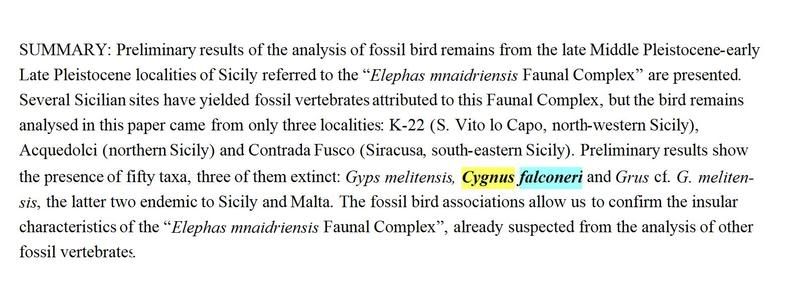|
|
Post by another specialist on Jul 25, 2008 9:31:07 GMT
Well i'm not sure whether it is really the same species. Malta and Sicily were already separated islands 10,000 years ago but I could imagine that both species could have had the same ancestor. A nice pic by the way. What Bucardo states seems to be correct  www.cq.rm.cnr.it/elephants2001/pdf/497_501.pdf www.cq.rm.cnr.it/elephants2001/pdf/497_501.pdf. |
|
|
|
Post by another specialist on Jul 25, 2008 9:33:14 GMT
I've learned that cygnus falconeri was a huge flightless swan,one-fourth larger than cynus olor and had a wingspan of 9 feet. Is this true? Can anyone tell me more about the size of this bird? The giant extinct Maltese Swan is shown in this work to have been a land-feeding bird, well adapted for walking but with little or no ability to fly. Fossils of the swan prepared during this study comprise the most representative remains in existence; the greater part of the foot skeleton and the frontal part of the cranium are described for the first time. By comparison of the bones with those of living swans I estimate that it probably resembled a scaled-up Whooper Swan weighing about 16 kg and with a wing span of about 3 m. www3.interscience.wiley.com/journal/119556335/abstract?CRETRY=1&SRETRY=0 |
|
|
|
Post by Peter on Jan 1, 2015 22:33:12 GMT
Summary
The giant extinct Maltese Swan is shown in this work to have been a land-feeding bird, well adapted for walking but with little or no ability to fly. Fossils of the swan prepared during this study comprise the most representative remains in existence; the greater part of the foot skeleton and the frontal part of the cranium are described for the first time. By comparison of the bones with those of living swans I estimate that it probably resembled a scaled-up Whooper Swan weighing about 16 kg and with a wing span of about 3 m.
NORTHCOTE, E. M. (1982), SIZE, FORM AND HABIT OF THE EXTINCT MALTESE SWAN CYGNUS FALCONERI. Ibis, 124: 148–158. doi: 10.1111/j.1474-919X.1982.tb03753.x
|
|
|
|
Post by Peter on Jan 1, 2015 22:56:20 GMT
Tyrberg, T. (2009). Holocene avian extinctions. In: Turvey, S.T. (editor) (2009). Holocene extinctions. Oxford University Press, Oxford, UK.
|
|
|
|
Post by Peter on Jan 1, 2015 23:17:04 GMT
Young, H. G., S. J. Tonge, J. P. Hume. 1997. Review of Holocene wildfowl extinctions. Wildfowl 47: 166-180.
|
|